GPO – Apply to a specific user or group
GPO – Apply to a specific user or group
Would you like to learn how to apply a group policy to a specific user account? In this tutorial, we will show you how to configure the GPO permissions to apply its configurations to a specific user or group.
• Windows 2012 R2
• Windows 2016
• Windows 2019
• Windows 10
• Windows 7
Tutorial GPO – Apply to a specific user
On the domain controller, open the group policy management tool.

Create a new group policy.
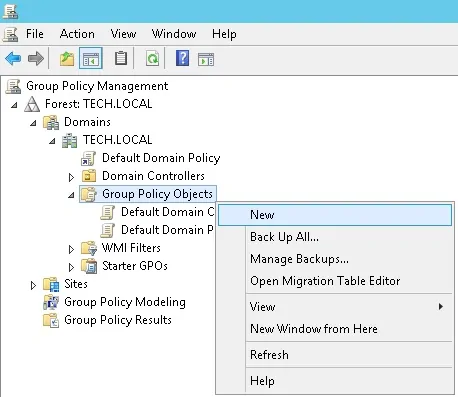
Enter a name for the new group policy.
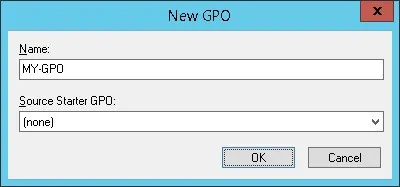
In our example, the new GPO was named: MY-GPO.
On the Group Policy Management screen, select your GPO and access the Delegation tab.
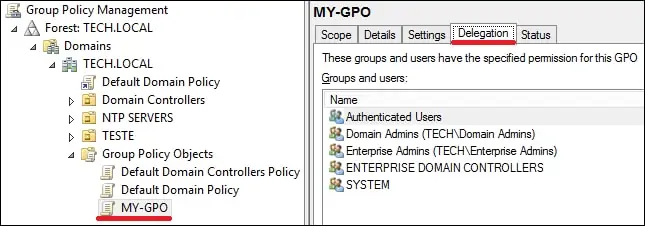
On the bottom of the screen, click on the Advanced button.
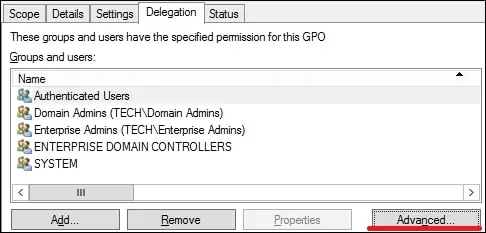
Select the Authenticated users group and uncheck the permission to apply the group policy.
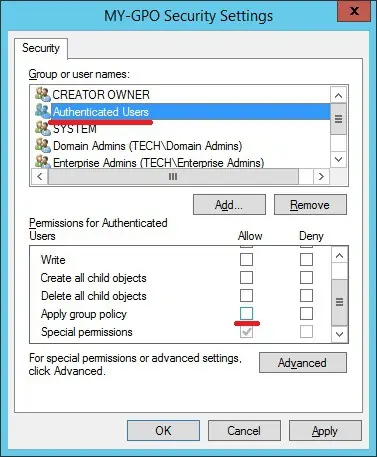
Click on the Add button and enter a user account.
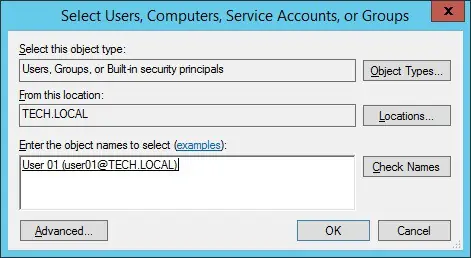
Select the user account and give permission to apply the group policy.
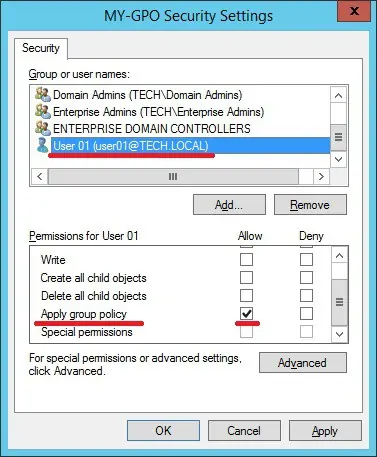
Optionally, you may apply the GPO to a specific group of users.
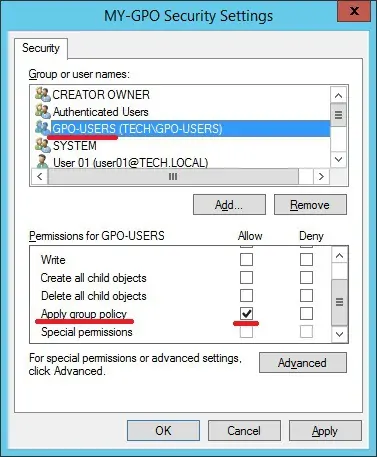
In our example, the account USER01 was given permission to apply the GPO named MY-GPO.
https://googleads.g.doubleclick.net/pagead/ads?client=ca-pub-8966925278215023&output=html&h=192&slotname=1035974290&adk=1035714401&adf=407349128&pi=t.ma~as.1035974290&w=767&fwrn=4&lmt=1665731999&rafmt=11&format=767×192&url=https%3A%2F%2Ftechexpert.tips%2Fwindows%2Fgpo-apply-to-specific-user-group%2F&wgl=1&uach=WyJXaW5kb3dzIiwiMTQuMC4wIiwieDg2IiwiIiwiMTA2LjAuNTI0OS4xMTkiLFtdLGZhbHNlLG51bGwsIjY0IixbWyJDaHJvbWl1bSIsIjEwNi4wLjUyNDkuMTE5Il0sWyJHb29nbGUgQ2hyb21lIiwiMTA2LjAuNTI0OS4xMTkiXSxbIk5vdDtBPUJyYW5kIiwiOTkuMC4wLjAiXV0sZmFsc2Vd&dt=1665737228457&bpp=1&bdt=855&idt=168&shv=r20221012&mjsv=m202210100101&ptt=9&saldr=aa&abxe=1&cookie=ID%3D5e4de487726965db-222c1b36add700d5%3AT%3D1665649074%3ART%3D1665649074%3AS%3DALNI_MbvFTZ99k4-Adou2E4m6KTXgvn4tA&gpic=UID%3D00000b606b60dc42%3AT%3D1665649074%3ART%3D1665737229%3AS%3DALNI_Mb5eYnT5lB-PLria1f3xFBr4d9fyA&prev_fmts=767×280%2C767x192%2C728x90%2C253x600%2C253x600%2C253x600%2C253x600%2C253x600%2C253x600%2C0x0%2C253x600%2C253x600%2C253x600%2C1903x929%2C728x90%2C253x600%2C253x600%2C253x600&nras=3&correlator=5351448166844&frm=20&pv=1&ga_vid=630741583.1665649073&ga_sid=1665737229&ga_hid=994073893&ga_fc=1&rplot=4&u_tz=420&u_his=1&u_h=1080&u_w=1920&u_ah=1032&u_aw=1920&u_cd=24&u_sd=1&dmc=8&adx=402&ady=6005&biw=1903&bih=929&scr_x=0&scr_y=2316&eid=44759876%2C44759927%2C44759837%2C42531705%2C31069177%2C21065724&oid=2&psts=APxP-9BmjzT3JgjPVlVdGAJxRr3cGBuncU-jBS1jNOzzQfgte9dJtPqJQa-H_Q28L9iAA5VhMuAOHc_cFxh6NfVEuQ%2CAPxP-9BXnpkM6q9kqv6ETdT1_YZeH2lCZ-0GA4t7Epq54lXYzEP5XXp0NQHPXUlFS0wGdjx_WrDFbdcWwbXi_gQ%2CAPxP-9Aqnkr52Mqti5hjd640-poG9iJCacvEy5GCXzr9xrhmNKC4QBcYQmiKoS86h5FzDLMJEj8gpQzj9eaZSDo%2CAPxP-9AnTD9AWrX9r1gUppf0JQxVwyPH4XpPYV17WI9Qg_WxpuXs5WdS-jNp4SV3_ZG3vPjkzuhh_nECl8no-7Q%2CAPxP-9CSwAbJBMMEzaPQWfBnGytOrE9qinGVa0sZy71uVYTxIRZ6oaXd6YbY0ynDHOVCCUMlJ2CKNvYub60hvfYxfg%2CAPxP-9APj11Ioo7dpWR__3_VLyPT0VQyeych6NW99Dq3adWZF5dlwgRTfaUG3WgJe412umC-0JvCZpM66aWtTVaZSt4K7CnoUjtvvEeCgXed&pvsid=2977202659616754&tmod=1452689728&uas=0&nvt=1&ref=https%3A%2F%2Fwww.google.com%2F&eae=0&fc=896&brdim=0%2C0%2C0%2C0%2C1920%2C0%2C1920%2C1032%2C1920%2C929&vis=1&rsz=%7C%7CeEbr%7C&abl=CS&pfx=0&fu=128&bc=31&ifi=4&uci=a!4&btvi=13&fsb=1&xpc=0KVEOrQ7tj&p=https%3A//techexpert.tips&dtd=5930
Tutorial GPO – Applying the group policy
On the Group policy management screen, you need to right-click the Organizational Unit desired and select the option to link an existent GPO.

In our example, we are going to link the group policy named MY-GPO to the root of the domain.
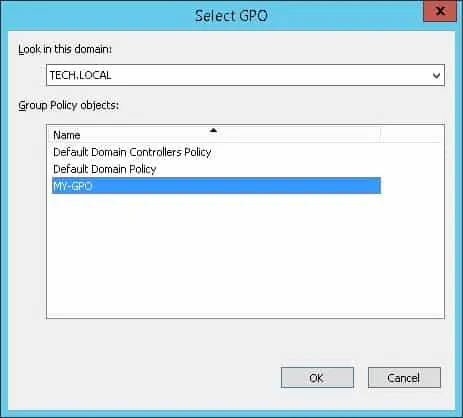
After applying the GPO you need to wait for 10 or 20 minutes.
During this time the GPO will be replicated to other domain controllers.
Reboot a remote computer and verify if the configuration was applied only on the selected user account.
In our example, only the account USER01 will apply the configurations from the GPO named MY-GPO
Has not absolutely understood, that you wished to tell it.
it is GPO apply with special user or group
You are similar to the expert)))